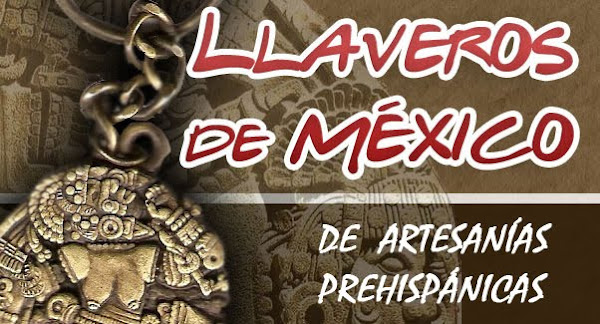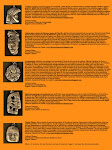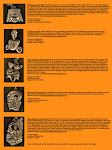

Llaveros de México. Coyolxauhqui. (náhuatl: Coyolxāuhqui [kojoɬˈʃaːʍki], cara pintada con cascabeles).
Diosa de la Luna de los aztecas. Hija de Coatlícue, la Tierra, y hermana de las cuatrocientas estrellas. Un día, cuando barría su templo en lo alto del cerro-Templo Mayor- de Coatepec, Coatlícue la Tierra, quedó embarazada milagrosamente gracias a una bolita de plumas de colibrí que cayó del cielo y que puso en su regazo. Coyolxauhqui, furiosa por la supuesta afrenta de su madre, se dirigió a matarla junto con sus hermanos. Huitzilopochtli, el Sol y dios de la guerra, desde el vientre de la Tierra advirtió el peligro y defendió su vida y la de su madre naciendo en ese momento como un guerrero y, decapitando a Coyolxauhqui con una serpiente de fuego, los lanzó, a ella y a sus hermanos, al firmamento. Así, ella se convirtió en la Luna y sus hermanos en las estrellas. En su caída, la diosa se fue desmembrando en cada giro. Se dice que esta batalla primera es la base mítica de los sacrificios humanos aztecas en honor a Huitzilopochtli, el Sol, dios de la guerra. La escultura tiene 3.25 metros de diámetro en promedio, 8 toneladas de peso y está hecha en piedra volcánica. Su desmembramiento es la explicación de un fenómeno celeste, en el cual la Luna muere y nace por fases, cada mes derrotada por el Sol, a pedazos. Así fue encontrada Coyolxauhqui al pie de la escalinata de Huitzilopochtli en el Templo Mayor.
Cultura: Azteca
Procedencia: Templo Mayor
Región: Centro de México, DF
Más…El relieve muestra a la diosa decapitada y mutilada de brazos y piernas, con gotas de sangre que emanan de sus extremidades y que dejan expuestas las coyunturas óseas. Está adornada con un cinturón de serpiente bicéfala rematado con un cráneo en su espalda. La serpiente de dos cabezas se repite en los atados de muslos y brazos. Las articulaciones y los talones de sus pies están adornados con mascarones compuestos por un rostro de perfil provisto de colmillos, cuyo significado todavía se presta a las más variadas conjeturas. Lleva sus sandalias, muñequeras y tobilleras. Su tronco, con los pechos caídos, está de frente, mientras que sus caderas dan un inusitado giro mostrándose de perfil y obligando a las extremidades a colocarse de igual forma. Su cabeza porta un gran penacho de plumas y su pelo está adornado con círculos. Sus orejeras, compuestas por tres figuras geométricas, enmarcan su rostro cuyo ornamento principal, los cascabeles en la mejilla, da nombre a la diosa Luna, de la que parece salir el último aliento de vida a través de su boca entreabierta; se distinguen pequeñas bolas de plumas de águila en el cabello y una pestaña mexica con el símbolo mexica para año en su oreja. Los estudiosos creen que la decapitación y el desmembramiento de Coyolxauhqui se reflejan en el patrón de los sacrificios rituales de guerreros. Primero, los corazones de los cautivos eran extraídos del pecho. Entonces eran decapitados y desmembrados. Finalmente, sus cuerpos eran arrojados desde el templo por las escalinatas de la pirámide, quizás sobre la gran piedra de Coyolxauhqui.
Keychains of Mexico. Coyolxauhqui (náhuatl: Coyolxāuhqui [kojoɬˈʃaːʍki], face painted with rattles).
Goddess of the Moon for the Aztecs or Mexicas. Daughter of Coatlícue, the Earth, and sister of the four hundred stars. One day, while sweeping her temple on top of the hill-Great Temple-of Coatepec, Coatlícue the Earth, became pregnant miraculously due to a small ball of hummingbird feathers that dropped from the sky which she put away inside her dress. Coyolxauhqui, furious by her mother’s supposed affront, went to kill her along with her brothers. Huitzilopochtli, the Sun and god of war, saw the danger from the Earth’s womb, and defended his life and his mother’s by being born in that moment as a warrior; he decapitated Coyolxauhqui with a fire serpent and threw her and his brothers into the sky. Thus, she became the Moon, and his brothers the stars. Upon her fall, the goddess dismembered with each tumble. It is said that this first battle is the mythic basis of the Aztec human sacrifices in honor to Huitzilopochtli, the Sun, god of war. The sculpture has 3.25 meters in diameter in average, 8 tons of weight and is made of volcanic stone. Her dismemberment is the explanation of a celestial phenomenon, in which the Moon is born and dies by phases, each month defeated by the Sun; piece by piece. Like this is how Coyolxauhqui was found at the base of the stairs of Huitzilopochtli, at the Great Temple (Templo Mayor).
Culture: Aztec
Location: Great Temple (Templo Mayor)
Region: Center of Mexico, DF
More…The relief shows the goddess, decapitated and mutilated of arms and legs, with drops of blood flowing from her extremities and exposing the bone unions. She is decorated with a belt of a two headed serpent, with an added skull on her back. The two headed serpent is repeated on the ties of legs and arms. The articulations and the heels of her feet are decorated with grotesque heads composed of a profiled head with fangs, which meaning is still object of the most different opinions. She carries her sandals, wristbands and ankle bands. Her chest, with the breasts hanging, is upwards, while her hips make an unusual twist, lying sideways and making the extremities be placed the same way. Her head wears a great feather bonnet and her hair is decorated with circles. Her earmuffs, composed by three geometric figures, frame her face,of which main ornament, the rattles on the cheek, give name to the the Moon, of whom the last breath of life appears to be leaving through her half open mouth; small eagle feather balls can be distinguished on the hair and a Mexica eyelash with the Mexica symbol for year in her ear. The scholars believe that the decapitation and dismemberment of Coyolxauhqui reflect in the pattern of warrior ritual sacrifices. First, the hearts of the captive were extracted from the chest. Then they were decapitated and dismembered. Finally, their bodies were thrown from the top of the Great Temple through the stairs of the pyramid, perhaps over the great stone of Coyolxauhqui.


